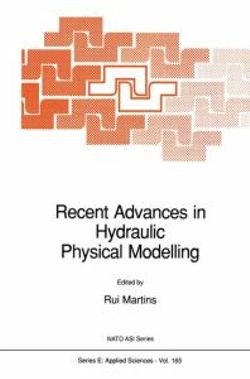The growing use of mathematical models in hydraulics has not made physical models obsolete. They keep pace with mathematical models and in some cases make progress in conjunction with them Physical models continue to be developed: more precise use of similitude criteria, better knowledge of scale effects, new and more complex types of model,use of various artifices, more ade- quate instrumentation, automation of the operation of model- all these pOint to that development. What was needed was to make a survey of the situation, and this was the principal aim of the NATO Advanced Study Institute on Recent Advances in Hydraulic Physical Modelling, which took place on the premises of the Laborat6rio Nacional de Engenharia Civil (LNEC) in Lisbon, Portugal, from 4th to 15th July 1988, and of which this book is one of the main outputs. It is divided into 11 chapters, corresponding to 28 lectures that cover five areas: fundamentals of physical modelling, river models, hydraulics of structures, maritime hvdraulics and densi ty models. -- Hodelling is obviously dependent on the knowledge of the phe- nomena that are being modelled.
This book is therefore also a book on hydraulic engineering in general and not only on phv- sical, modelling. The text also refers to mathematical modelling, experimental methods in hydraulics and observation of nature and prototypes.
- ISBN:
- 9789401075558
- 9789401075558
-
Category:
- Structural engineering
- Format:
- Paperback
- Publication Date:
-
27-09-2011
- Language:
- English
- Publisher:
- Springer
- Country of origin:
- Netherlands
- Pages:
- 627
- Dimensions (mm):
- 235x155x33mm
- Weight:
- 0.98kg
This title is in stock with our Australian supplier and should arrive at our Sydney warehouse within 2 - 3 weeks of you placing an order.
Once received into our warehouse we will despatch it to you with a Shipping Notification which includes online tracking.
Please check the estimated delivery times below for your region, for after your order is despatched from our warehouse:
ACT Metro 2 working days
NSW Metro 2 working days
NSW Rural 2 - 3 working days
NSW Remote 2 - 5 working days
NT Metro 3 - 6 working days
NT Remote 4 - 10 working days
QLD Metro 2 - 4 working days
QLD Rural 2 - 5 working days
QLD Remote 2 - 7 working days
SA Metro 2 - 5 working days
SA Rural 3 - 6 working days
SA Remote 3 - 7 working days
TAS Metro 3 - 6 working days
TAS Rural 3 - 6 working days
VIC Metro 2 - 3 working days
VIC Rural 2 - 4 working days
VIC Remote 2 - 5 working days
WA Metro 3 - 6 working days
WA Rural 4 - 8 working days
WA Remote 4 - 12 working days


Share This Book: